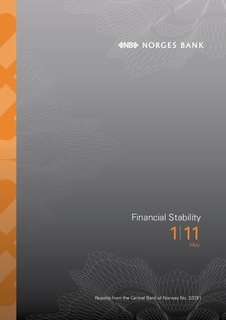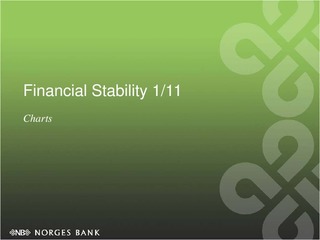| dc.contributor.editor | Olsen, Øystein | |
| dc.date.accessioned | 2018-09-19T07:39:09Z | |
| dc.date.available | 2018-09-19T07:39:09Z | |
| dc.date.issued | 2011 | |
| dc.identifier.issn | 1502-2749 | |
| dc.identifier.issn | 1503-8858 | |
| dc.identifier.uri | http://hdl.handle.net/11250/2563343 | |
| dc.description | Financial stability implies that the financial system is robust to disturbances in the economy and can channel capital, execute payments and redistribute risk in a satisfactory manner. Financial stability is one of Norges Bank’s primary objectives in the work on promoting economic stability. Norges Bank’s tasks and responsibilities in this area are set out in Section 1 of the Norges Bank Act, which states that the Bank shall “promote an efficient payment system domestically as well as vis-à-vis other countries”, but that the Bank may also “implement any measures customarily or ordinarily taken by a central bank”. Section 3 states that “the Bank shall inform the ministry when, in the opinion of the Bank, there is a need for measures to be taken by others than the Bank in the field of monetary, credit or foreign exchange policy”. Norges Bank acts as lender of last resort. The central bank shall provide extraordinary liquidity to individual institutions in the financial sector or to the banking system when liquidity demand cannot be satisfied from alternative sources. The role of lender of last resort provides an independent justification for Norges Bank’s function in monitoring the financial system as a whole and its particular focus on the risk of systemic failure. Experience shows that the foundation for financial instability is laid during periods of strong debt growth and asset price inflation. Banks play a key role in credit provision and payment services – and they differ from other financial institutions in that they rely on customer deposits for funding. Banks are thus important to financial stability. The Financial Stability report therefore focuses on the prospects for banks’ earnings and financial strength and the risk factors to which banks are exposed. The report is published twice a year. The report is presented to the Executive Board for discussion of the main conclusions. On the basis of the analyses and the discussion, the Executive Board adopts recommendations for measures to be implemented by the authorities. The “Executive Board’s assessment” is published in the report and communicated in a submission to the Ministry of Finance. Norges Bank’s Annual Report on Payment Systems provides a broader overview of risk and developments in the Norwegian payment system. | nb_NO |
| dc.language.iso | eng | nb_NO |
| dc.publisher | Norges Bank | nb_NO |
| dc.relation.ispartofseries | Financial Stability Report;1/2011 | |
| dc.relation.ispartofseries | Reports from the Central Bank of Norway;No. 2/2011 | |
| dc.rights | Attribution-NonCommercial-NoDerivatives 4.0 Internasjonal | * |
| dc.rights.uri | http://creativecommons.org/licenses/by-nc-nd/4.0/deed.no | * |
| dc.title | Financial Stability 1/11 | nb_NO |
| dc.type | Report | nb_NO |
| dc.description.version | publishedVersion | nb_NO |
| dc.subject.nsi | VDP::Samfunnsvitenskap: 200::Økonomi: 210::Samfunnsøkonomi: 212 | nb_NO |
| dc.source.pagenumber | 46 | nb_NO |


